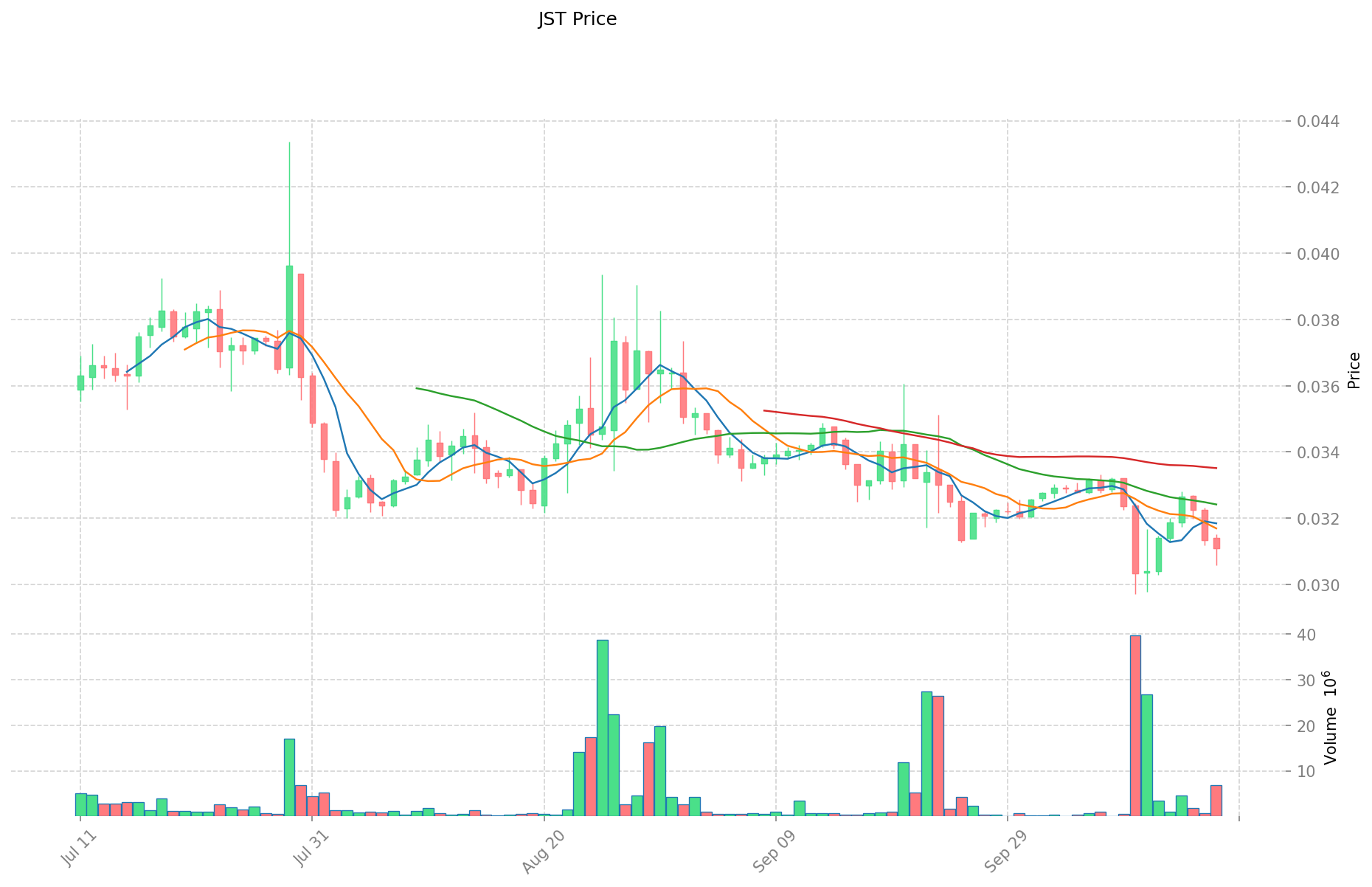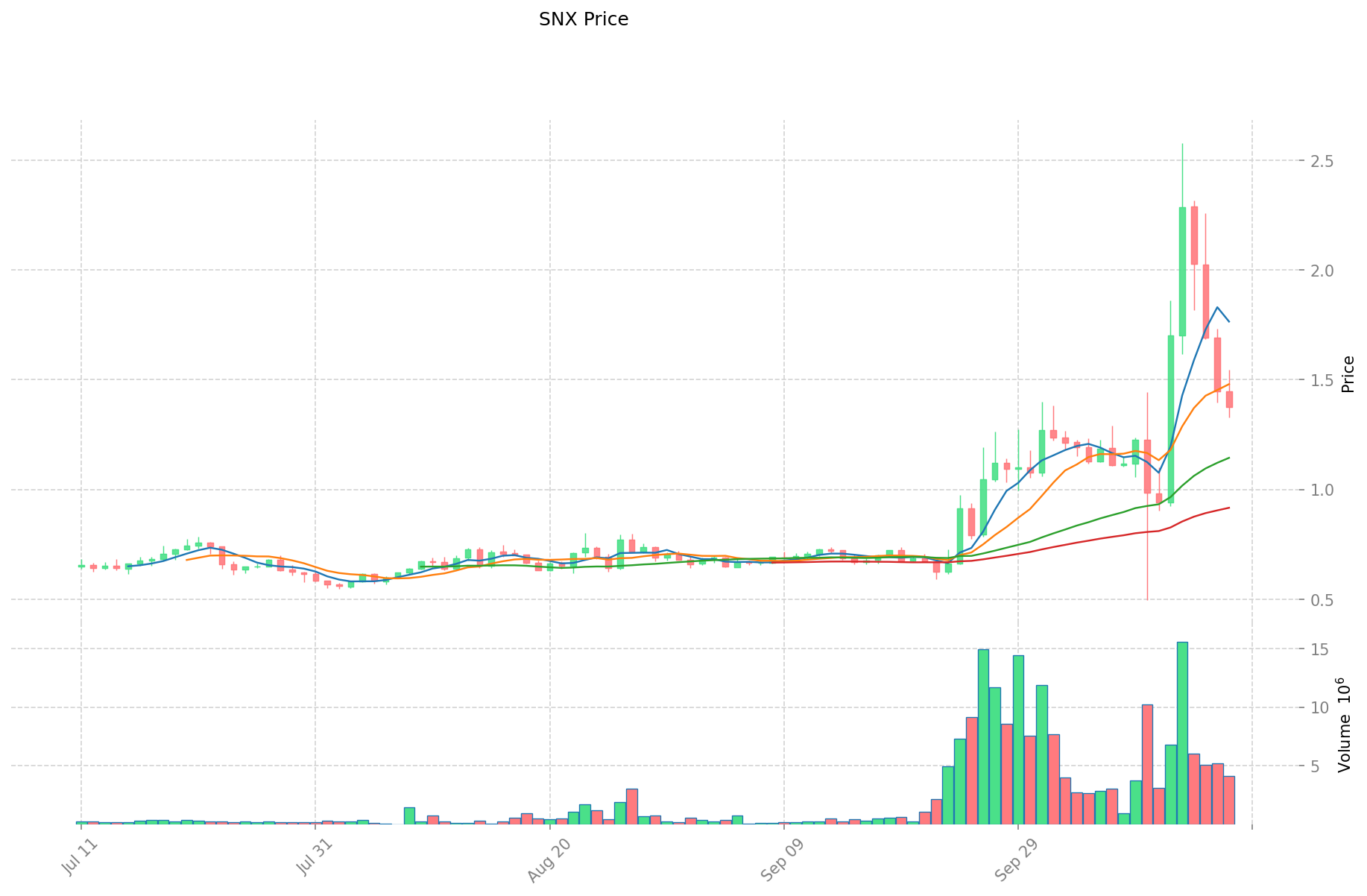JST vs SNX: A Comparative Analysis of Two Synthetic Asset Protocols in DeFi
Introduction: JST vs SNX Investment Comparison
In the cryptocurrency market, the comparison between JST and SNX has always been a topic that investors can't ignore. The two not only have significant differences in market cap ranking, application scenarios, and price performance, but also represent different positioning in the crypto asset space.
Just (JST): Since its launch in 2020, it has gained market recognition for its goal of establishing a fair decentralized financial system and providing stable currency lending and governance mechanisms.
Synthetix (SNX): Launched in 2018, it has been hailed as a platform designed for engineers to build decentralized and trustless networks, supporting a variety of synthetic assets.
This article will comprehensively analyze the investment value comparison between JST and SNX, focusing on historical price trends, supply mechanisms, institutional adoption, technological ecosystems, and future predictions, attempting to answer the question that investors are most concerned about:
"Which is the better buy right now?"
I. Price History Comparison and Current Market Status
JST and SNX Historical Price Trends
- 2020: JST launched at $0.002, experiencing initial volatility as a new token.
- 2021: SNX reached its all-time high of $28.53 on February 14, driven by the DeFi boom.
- Comparative analysis: During the 2021 bull market, JST rose from its launch price to an all-time high of $0.193254, while SNX saw a more significant increase from its low of $0.0347864 to its peak.
Current Market Situation (2025-10-18)
- JST current price: $0.03102
- SNX current price: $1.3841
- 24-hour trading volume: JST $209,926.64 vs SNX $5,996,990.70
- Market Sentiment Index (Fear & Greed Index): 22 (Extreme Fear)
Click to view real-time prices:
- Check JST current price Market Price
- Check SNX current price Market Price


II. Core Factors Affecting JST vs SNX Investment Value
Supply Mechanism Comparison (Tokenomics)
- JST: JST has a total supply of 9,900,000,000 tokens, with circulating supply representing a portion of this total. The JUST network uses a deflationary model where tokens are burned through network activity.
- SNX: Synthetix has an inflationary supply model with SNX tokens issued as rewards to stakers. The protocol has implemented several mechanisms to control inflation, including adjustments to staking rewards.
- 📌 Historical Pattern: Deflationary tokens like JST tend to gain value during high network usage periods, while SNX's value is closely tied to staking participation rates and protocol revenue.
Institutional Adoption and Market Applications
- Institutional Holdings: SNX has attracted more institutional interest due to its established position in the DeFi derivatives space and partnerships with other major DeFi protocols.
- Enterprise Adoption: JST is primarily used within the JUST/TRON ecosystem for governance and stablecoin operations, while SNX serves as collateral for synthetic assets across various financial applications.
- Regulatory Stance: Both tokens operate in regulatory gray areas in many jurisdictions, though SNX faces more scrutiny due to its derivative products potentially falling under securities regulations.
Technical Development and Ecosystem Building
- JST Technical Upgrades: Recent improvements focus on enhancing the JUST protocol's stablecoin stability mechanisms and governance processes within the TRON ecosystem.
- SNX Technical Development: Synthetix has been implementing V3 upgrades focusing on cross-chain functionality, improved capital efficiency, and reduced gas costs through optimistic rollups.
- Ecosystem Comparison: SNX has deeper integration within the broader DeFi ecosystem, particularly in derivatives and synthetic assets. JST is more focused on stablecoin issuance (USDJ) and lending within the TRON ecosystem.
Macroeconomic Factors and Market Cycles
- Inflation Environment Performance: SNX has historically shown more correlation with broader crypto market movements, while JST tends to be more stable due to its stablecoin backing mechanism.
- Macroeconomic Monetary Policy: Both tokens are affected by Federal Reserve decisions and interest rate changes, with SNX typically showing higher volatility during policy shifts.
- Geopolitical Factors: JST benefits from TRON's strong presence in Asian markets, while SNX has greater exposure to Western market dynamics and regulatory developments.
III. 2025-2030 Price Prediction: JST vs SNX
Short-term Prediction (2025)
- JST: Conservative $0.024872 - $0.03109 | Optimistic $0.03109 - $0.0432151
- SNX: Conservative $1.29941 - $1.3678 | Optimistic $1.3678 - $1.84653
Mid-term Prediction (2027)
- JST may enter a growth phase, with estimated prices ranging from $0.0351463123 to $0.0555151978375
- SNX may enter a volatile phase, with estimated prices ranging from $0.967191897 to $2.067135623
- Key drivers: Institutional capital inflow, ETF, ecosystem development
Long-term Prediction (2030)
- JST: Base scenario $0.06987604594414 - $0.092236380646265 | Optimistic scenario $0.092236380646265+
- SNX: Base scenario $2.8629012903029 - $4.122577858036176 | Optimistic scenario $4.122577858036176+
Disclaimer: This analysis is based on historical data and current market trends. Cryptocurrency markets are highly volatile and unpredictable. These predictions should not be considered as financial advice. Always conduct your own research before making investment decisions.
JST:
| 年份 | 预测最高价 | 预测平均价格 | 预测最低价 | 涨跌幅 |
|---|---|---|---|---|
| 2025 | 0.0432151 | 0.03109 | 0.024872 | 0 |
| 2026 | 0.0427254325 | 0.03715255 | 0.028235938 | 19 |
| 2027 | 0.0555151978375 | 0.03993899125 | 0.0351463123 | 28 |
| 2028 | 0.068249745197562 | 0.04772709454375 | 0.045818010762 | 53 |
| 2029 | 0.081763672017625 | 0.057988419870656 | 0.051029809486177 | 86 |
| 2030 | 0.092236380646265 | 0.06987604594414 | 0.037034304350394 | 125 |
SNX:
| 年份 | 预测最高价 | 预测平均价格 | 预测最低价 | 涨跌幅 |
|---|---|---|---|---|
| 2025 | 1.84653 | 1.3678 | 1.29941 | -1 |
| 2026 | 2.1857444 | 1.607165 | 1.30180365 | 16 |
| 2027 | 2.067135623 | 1.8964547 | 0.967191897 | 37 |
| 2028 | 2.635787564795 | 1.9817951615 | 1.34762070982 | 43 |
| 2029 | 3.4170112174583 | 2.3087913631475 | 1.223659422468175 | 66 |
| 2030 | 4.122577858036176 | 2.8629012903029 | 2.777014251593813 | 106 |
IV. Investment Strategy Comparison: JST vs SNX
Long-term vs Short-term Investment Strategies
- JST: Suitable for investors focused on stablecoin ecosystems and TRON network growth
- SNX: Suitable for investors interested in DeFi derivatives and synthetic asset exposure
Risk Management and Asset Allocation
- Conservative investors: JST: 60% vs SNX: 40%
- Aggressive investors: JST: 40% vs SNX: 60%
- Hedging tools: Stablecoin allocation, options, cross-currency portfolios
V. Potential Risk Comparison
Market Risks
- JST: Highly dependent on TRON ecosystem adoption and stablecoin demand
- SNX: More susceptible to broader DeFi market fluctuations and liquidity risks
Technical Risks
- JST: Scalability, network stability within TRON ecosystem
- SNX: Smart contract vulnerabilities, oracle dependency
Regulatory Risks
- Global regulatory policies may impact SNX more due to its involvement in synthetic assets
VI. Conclusion: Which Is the Better Buy?
📌 Investment Value Summary:
- JST advantages: Stablecoin ecosystem integration, deflationary model
- SNX advantages: Established DeFi presence, synthetic asset exposure
✅ Investment Advice:
- Novice investors: Consider a higher allocation to JST for its relative stability
- Experienced investors: Balanced approach with a slight tilt towards SNX for higher potential returns
- Institutional investors: Strategic allocation to both, with SNX for DeFi exposure and JST for stablecoin ecosystem participation
⚠️ Risk Warning: Cryptocurrency markets are highly volatile. This article does not constitute investment advice. None
VII. FAQ
Q1: What are the main differences between JST and SNX? Answer: JST is primarily used within the JUST/TRON ecosystem for governance and stablecoin operations, while SNX serves as collateral for synthetic assets across various DeFi applications. JST has a deflationary model, whereas SNX has an inflationary supply model with tokens issued as rewards to stakers.
Q2: Which token has shown better historical price performance? Answer: During the 2021 bull market, SNX showed a more significant increase, rising from its low of $0.0347864 to an all-time high of $28.53. JST rose from its launch price of $0.002 to an all-time high of $0.193254.
Q3: How do the current market situations of JST and SNX compare? Answer: As of 2025-10-18, JST's price is $0.03102 with a 24-hour trading volume of $209,926.64, while SNX's price is $1.3841 with a 24-hour trading volume of $5,996,990.70. The overall market sentiment is in "Extreme Fear" with a Fear & Greed Index of 22.
Q4: What are the long-term price predictions for JST and SNX by 2030? Answer: For JST, the base scenario predicts a range of $0.06987604594414 to $0.092236380646265, with an optimistic scenario above $0.092236380646265. For SNX, the base scenario predicts a range of $2.8629012903029 to $4.122577858036176, with an optimistic scenario above $4.122577858036176.
Q5: How do the investment strategies for JST and SNX differ? Answer: JST is more suitable for investors focused on stablecoin ecosystems and TRON network growth, while SNX is better for those interested in DeFi derivatives and synthetic asset exposure. Conservative investors might allocate 60% to JST and 40% to SNX, while aggressive investors might do the opposite.
Q6: What are the main risks associated with investing in JST and SNX? Answer: JST's risks include high dependence on TRON ecosystem adoption and stablecoin demand, as well as scalability and network stability issues. SNX is more susceptible to broader DeFi market fluctuations, liquidity risks, smart contract vulnerabilities, and potential regulatory challenges due to its involvement in synthetic assets.
Q7: Which token might be a better buy for different types of investors? Answer: Novice investors might consider a higher allocation to JST for its relative stability. Experienced investors could take a balanced approach with a slight tilt towards SNX for higher potential returns. Institutional investors might strategically allocate to both, using SNX for DeFi exposure and JST for stablecoin ecosystem participation.
Share
Content